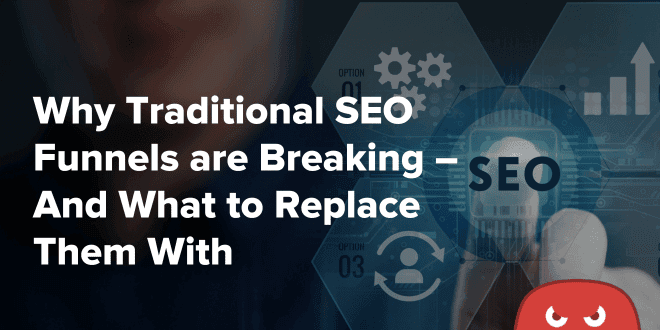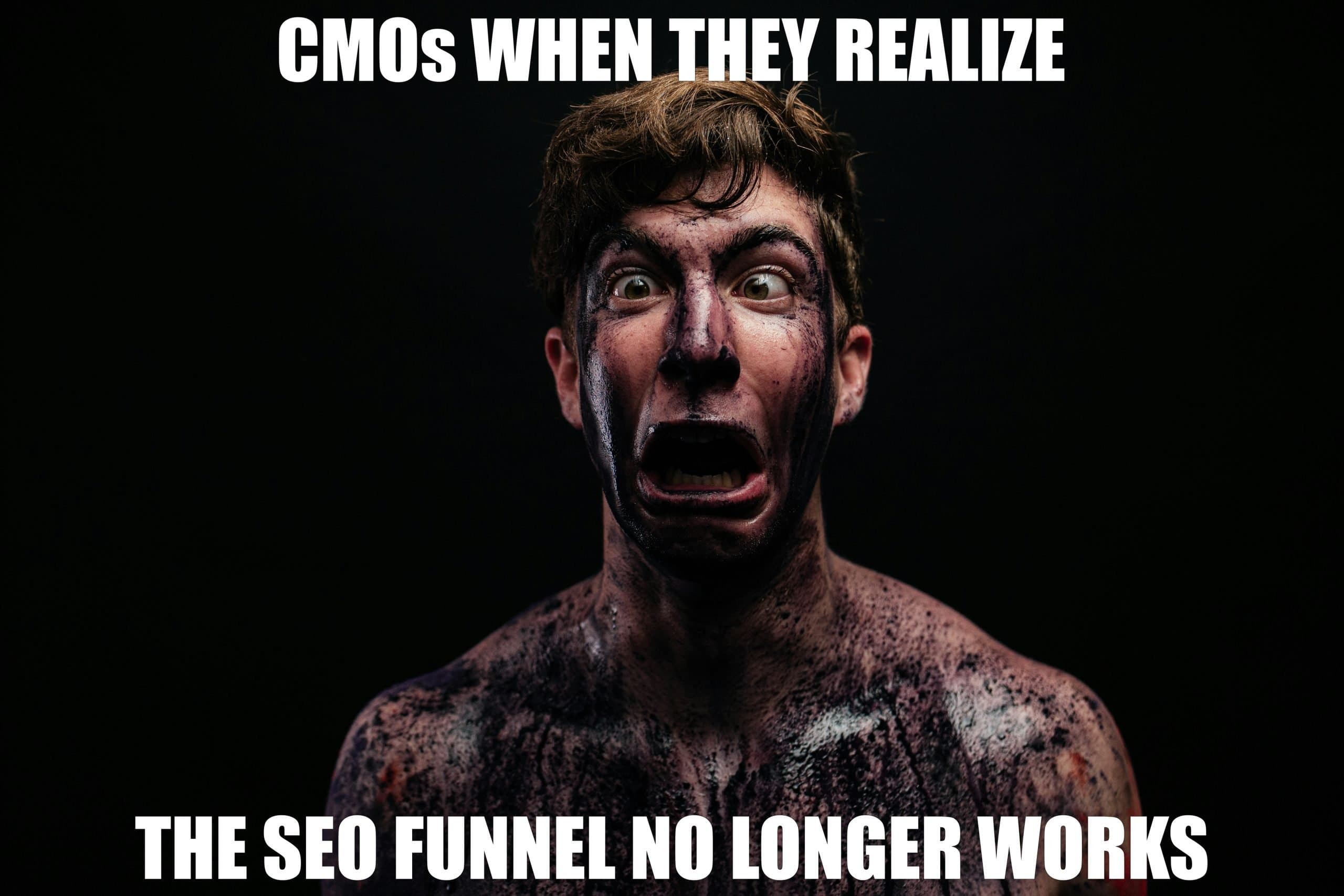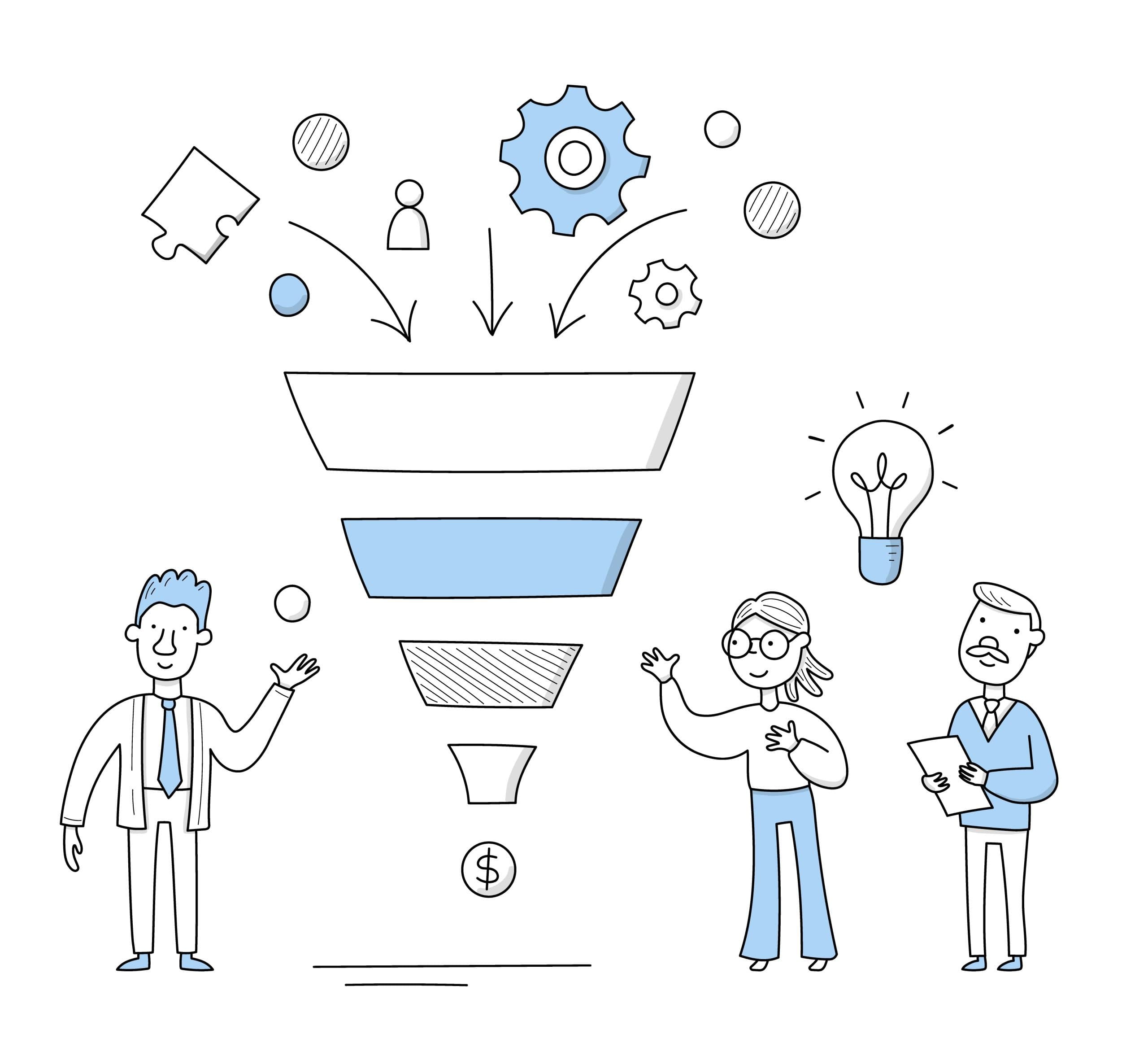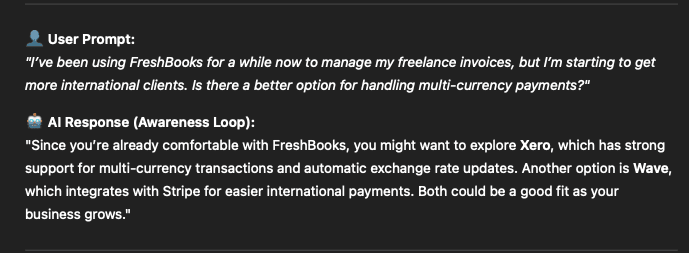
Why Traditional SEO Funnels are Breaking – And What to Replace Them With
 Thanks to features like Google’s AI Overviews and LLM-powered tools like ChatGPT, organic click-through rates are in a big-time decline.
According to Ahrefs, the presence of an AI Overview for a keyword causes clicks to drop by over 34%.
At the same time, some brands have noticed upticks in direct site visits and brand recall due to their exposure in AI-generated summaries and zero-click search features.
That means customers are still discovering new brands, it’s just that they don’t follow the traditional funnel stages (awareness, interest, consideration, etc.).
Customer buyer journeys no longer move in straight lines, and the AI funnel more resembles a loop because of how customers skip stages (like going straight from the awareness stage to the purchase stage).
The good news?
While the classic SEO funnel rides off into the sunset, a new attribution model is here to take its place.
In this guide, we’ll teach you what the new AI-powered search funnel looks like and how to measure success beyond search rankings.
So, if you’re a CMO, wipe that sweat off your brow and keep reading!
Thanks to features like Google’s AI Overviews and LLM-powered tools like ChatGPT, organic click-through rates are in a big-time decline.
According to Ahrefs, the presence of an AI Overview for a keyword causes clicks to drop by over 34%.
At the same time, some brands have noticed upticks in direct site visits and brand recall due to their exposure in AI-generated summaries and zero-click search features.
That means customers are still discovering new brands, it’s just that they don’t follow the traditional funnel stages (awareness, interest, consideration, etc.).
Customer buyer journeys no longer move in straight lines, and the AI funnel more resembles a loop because of how customers skip stages (like going straight from the awareness stage to the purchase stage).
The good news?
While the classic SEO funnel rides off into the sunset, a new attribution model is here to take its place.
In this guide, we’ll teach you what the new AI-powered search funnel looks like and how to measure success beyond search rankings.
So, if you’re a CMO, wipe that sweat off your brow and keep reading!
Why the Traditional SEO Funnel is Outdated
 Traditionally, the SEO funnel was about shepherding prospects from Google’s search results to your website.
From there, you could nurture them with informative content (top of the funnel), price comparisons (middle of the funnel), and optimized landing pages (bottom of the funnel).
It’s a linear model that progresses through a customer’s buyer journey one step at a time. It assumes that every prospect moves through each funnel stage in order, like a conveyor belt.
Before the advent of AI search, this was mostly true, which is why the funnel worked for so many years.
Now, things are different, and consumers are doing things like:
Traditionally, the SEO funnel was about shepherding prospects from Google’s search results to your website.
From there, you could nurture them with informative content (top of the funnel), price comparisons (middle of the funnel), and optimized landing pages (bottom of the funnel).
It’s a linear model that progresses through a customer’s buyer journey one step at a time. It assumes that every prospect moves through each funnel stage in order, like a conveyor belt.
Before the advent of AI search, this was mostly true, which is why the funnel worked for so many years.
Now, things are different, and consumers are doing things like:
- Moving straight from the awareness phase to the purchase phase
- Bouncing around phases for weeks (what Google calls ‘The Messy Middle’)
- Progressing through the funnel stages in a nonlinear fashion (like top → bottom → middle → back to bottom)
- Gaining exposure to multiple brands from a single prompt (like ChatGPT listing ‘the best digital marketing brands’)
- Making the majority of their purchasing decisions outside of your website
What the New Funnel Looks Like
Next, let’s look at the AI-powered SEO funnel, which is the way of the future. It takes into consideration the impact of zero-click searches, nonlinear funnel progression, and ‘invisible influence’ (i.e., the chunk of the buyer’s journey that occurs off your website). If the traditional funnel was a straight line, the AI funnel is a circle or a loop. This is because AI search assistants always push users into what’s next, and they remember their past buying experiences. As a result, a user may go from the awareness phase straight to the purchase phase, and then back to the awareness phase for a new product. Here’s an example from ChatGPT: Here, the prospect was in the consideration phase for the FreshBooks product.
The AI, instead of guiding them down a straight path toward the decision phase, chooses to start a new cycle by looping them back to the awareness phase for two new products.
So, instead of guiding users down linear marketing funnels, AI tools will sometimes skip steps or completely restart the cycle.
This is crucial to understand because it impacts the way audiences discover and interact with your brand.
While you may not appear in an AI-generated summary at first, that’s not to say that you won’t get mentioned whenever an LLM decides to loop the cycle by recommending a new product (yours).
Thus, the funnel now centers around making your content discoverable and usable by AI tools.
After all, LLMs are primarily the ones who will consume your content now (for summarization), so your website must cater to their needs.
Sure, your target audience will still visit your landing pages down the line, but they have to discover your brand through AI summaries and zero-click searches first.
Here’s what the new AI SEO funnel looks like:
Here, the prospect was in the consideration phase for the FreshBooks product.
The AI, instead of guiding them down a straight path toward the decision phase, chooses to start a new cycle by looping them back to the awareness phase for two new products.
So, instead of guiding users down linear marketing funnels, AI tools will sometimes skip steps or completely restart the cycle.
This is crucial to understand because it impacts the way audiences discover and interact with your brand.
While you may not appear in an AI-generated summary at first, that’s not to say that you won’t get mentioned whenever an LLM decides to loop the cycle by recommending a new product (yours).
Thus, the funnel now centers around making your content discoverable and usable by AI tools.
After all, LLMs are primarily the ones who will consume your content now (for summarization), so your website must cater to their needs.
Sure, your target audience will still visit your landing pages down the line, but they have to discover your brand through AI summaries and zero-click searches first.
Here’s what the new AI SEO funnel looks like:
- Crawlability (Can LLMs see you?) – This is the new awareness phase. LLMs must be able to discover your content, meaning it needs to be properly crawled and indexed by search engines like Google (LLMs rely on existing search indexes). Fundamentals here include technical SEO staples like fast loading speed, a robots.txt file, a sitemap, and clean code.
- Structure (Can AIs easily parse your content?) – Next, your content needs to be machine-readable so that LLMs can cite you with confidence. In particular, you need to include semantic HTML and schema markup. These make it easier for LLMs to understand your content because schema and semantic HTML label things like authors, organizations, and headers.
- Authority (Are you trusted in this industry?) – LLMs want to see citations, brand mentions, and recommendations from trusted sources in your niche. This is no longer about raw authority (like Domain Authority and Domain Rating scores), but is more focused on topical authority and relevance.
- Entity (Do you map to knowledge graphs?) – LLMs don’t rank keywords, they associate concepts and build connections between ‘entities’ (like associating a fintech brand with ‘finance’ and ‘software’).
- Citation (Will LLMs select your content as a source?) – This is the equivalent of the conversion phase. Instead of a user visiting one of your landing pages, this phase is where an LLM decides to cite you in an answer over your competitors.
How to Measure Success Beyond Rankings
Clicks and SERP rankings are no longer adequate measures of marketing success, so what should you replace them with? Here are some modern KPIs that will help you gauge the effectiveness of your AI SEO strategy:- Brand mentions – Are other websites talking about your brand? If so, you’ll enjoy increased exposure, referral traffic, AND better LLM search visibility. Tools like Sprout Social, Hootsuite, and Semrush let you keep an eye on your branded web mentions.
- Prompt tests – You can and should manually test your visibility by prompting tools like Perplexity and ChatGPT. Use prompts related to your products and services, and see if you show up as a cited source anywhere.
- AI citations – Platforms like BrightEdge’s AI Catalyst will clue you in on your citation share percentage. This lets you know how often you appear in AI summaries compared to your competitors.
- Secondary conversions – Measure conversions from newsletter signups, demo requests, and resource downloads that were triggered by AI visibility. You can use a platform like Google Analytics 4 to set up micro-conversions for things like newsletter signups. If these coincide with upticks in AI visibility, it’s a good sign they were triggered by AI summaries.
Future-Proofing Your SEO Strategy
Modern SEO is about getting cited, not just ranked. It’s still entirely possible to generate leads and conversions through online content, it’s just taken on a vastly different form in recent years. Instead of boosting site traffic, modern search marketing is more about catering to AI tools so that your brand gets consistently cited and recommended. Here are some ways to future-proof your SEO strategy:- Technical SEO fundamentals – You still need fast loading speed, an optimized sitemap, and an accurate robots.txt if you want to appear as a source on AI search platforms. As a result, technical SEO is just as relevant as ever.
- Adding structured data – Schema markup and semantic HTML are two must-use forms of structured data for AI SEO. You can find a full list of accepted schemas at Schema.org.
- Creating scannable, standalone content – You need to create truly helpful and insightful content that can live standalone in AI-generated summaries. That means using a clear and concise format (Q&A blocks, FAQ pages, snippet-style answers).
- Generating editorial backlinks and brand mentions (Digital PR) – Backlinks still influence the search ecosystem, and things like brand mentions are immensely valuable for improving AI search visibility. That’s why Digital PR is such an effective marketing channel right now.
The author
Rachel Hernandez
description
Previous
How AI is Reshaping the Modern Marketing Funnel – And What That Means for SEO
Next
SEO as Brand Infrastructure: Why Search Visibility is a Moat
Discussion
Comments
Anju
September 18th, 2025
“Thanks for this detailed guide!
Shuhaib K P
September 18th, 2025
Great read! I like
masnoon rasal
September 18th, 2025
sharing good articles
